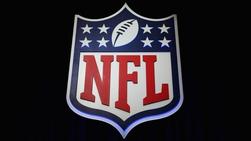 In this Feb 1, 2017 photo, the NFL shield logo is seen following a press conference held by NFL Commissioner Roger Goodell (not pictured) at the George R Brown Convention Center in Houston, Texas. (GETTY IMAGES NORTH AMERICA / AFP)
In this Feb 1, 2017 photo, the NFL shield logo is seen following a press conference held by NFL Commissioner Roger Goodell (not pictured) at the George R Brown Convention Center in Houston, Texas. (GETTY IMAGES NORTH AMERICA / AFP)
National Football League owners on the weekend officially approved a plan to expand the regular season by one game, starting this year.
The 17th game will feature match-ups between the two teams that finished in the same position within opposing divisions the previous season
Each team will play three preseason games ahead of a 17-game regular season. The schedule change is the first since going from 14 to 16 games in 1978.
In addition to the extended regular season, the NFL announced an expansion of international games, with all 32 clubs playing at least once abroad over an eight-year period, beginning in 2022.
"This is a monumental moment in NFL history," commissioner Roger Goodell said in a statement. "The CBA (collective bargaining agreement) with the players and the recently completed media agreements provide the foundation for us to enhance the quality of the NFL experience for our fans. And one of the benefits of each team playing 17 regular-season games is the ability for us to continue to grow our game around the world."
ALSO READ: NFL denies report on media rights deal with Disney
The 17th game will feature match-ups between the two teams that finished in the same position within opposing divisions the previous season. The AFC will be the home team in 2021, with the NFC hosting the games in 2022.
The extra game also means some long-standing records and milestones could soon be threatened. The offensive explosion in recent years that makes comparing marks from the 1970s and 80s to today's game a fruitless exercise will only become less useful as players put up even bigger statistics than the stars of the past decade.
Here's a look at three marks that could be most impacted by the change:
・ 5,000 yards passing
Dan Marino spent years as the sole member of the 5,000-yard passing club, having thrown for 5,084 yards in 1984 for the Miami Dolphins back when a 3,000-yard season was viewed as a major accomplishment.
Marino's mark stood for 24 years, until Drew Brees of the New Orleans Saints threw for 5,069 yards in 2008. Brees went on to throw for at least 5,000 yards in a season four more times, breaking Marino's record with 5,476 in 2011. Peyton Manning of the Indianapolis Colts eclipsed Brees by one yard in 2013, and now there have been a total of 12 5,000-yard seasons.
To break Manning's record, a passer would have to throw for a little more than 322 yards per game over a 17-game season. That's a mark that has been reached nine times in the past 10 seasons, which puts the record in serious jeopardy.
・ 2,000 yards receiving
Detroit Lions wide receiver Calvin Johnson came closest with 1,964 yards in 2012. To reach 2,000 yards in a season, a player would need to average more than 117 yards receiving per game. Doing that won't be easy with Johnson the only player to average that many over 16 games.
With teams passing more than ever, it might be inevitable that a receiver will reach the 2,000-yard mark in the next few years.
READ MORE: NFL champ honored for COVID-19 work
・ 1,000 yards rushing
This milestone will only be easier to reach now, reducing the yards necessary from 62.5 in 16 games to 58.9 in a 17-game campaign.
Twenty-nine players recorded 1,000-yard receiving seasons in 2019, a mark that was reached 14 times in the eight seasons before the NFL expanded to 16 games in 1978.
Tennessee Titans running back Derrick Henry might already hold the single-season rushing record had the 17-game season been in place last season. Henry ran for 2,027 yards in 2020, just 79 short of breaking Eric Dickerson's all-time mark of 2,105 set in 1984.


